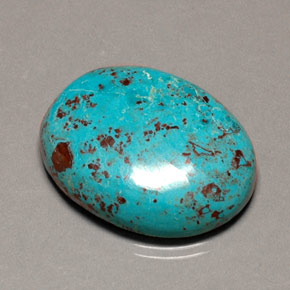The Gemstone Chrysocolla

Chrysocolla is a gemstone with a beautiful sky blue to bluish-green color. Copper in its chemical structure is responsible for the bright attractive color. It is often multicolored with inclusions or veining of black and brown matrix material. Chrysocolla's lack of widespread gem use is due to its low hardness and lack of durability. It is sometimes coated or admixed with harder Quartz, and these harder, more solid forms are better fit for gemstone use.
Color
?
Blue, Green, Multicolored
Chemical Formula
?
Cu
2H
2Si
2O
5(OH)
4
Mineral Class
?
Chrysocolla
Additional Properties
|
Refractive Index
?
1.4 - 1.6 |
Double Refraction
?
None |
Transparency
?
Opaque |
SG
?
2.0 - 2.2 |
Luster
?
Vitreous to greasy |
| Cleavage ?
None |
All About
Chrysocolla gemstones may be solid in color, but are more often multicolored blue and green, with interesting color patterns or mottling. Brown and black specks are often also admixed. Due to its color similarity to
Turquoise, Chrysocolla can be used as a
cheaper substitute and is occasionally falsely labelled as Turquoise.
A gem variety of Chrysocolla known as
Eilat Stone is a greenish-blue mixture of Chrysocolla,
Turquoise and other copper minerals such as Malachite from the ancient copper mines north of Eilat, in the southern Israel. Much of the material sold as Eilat Stone is in fact not really from Eilat but originates in other localities and is falsely labelled.
Uses
?
Chrysocolla is used as a minor opaque gemstone as well as a collectors gemstone. It is cut into
cabochons and beads and only occasionally into other gemstone cuts.
Treatments & Enhancements
?
Chrysocolla is natural and not treated or enhanced.
Chrysocolla Sources
?
Chrysocolla is found worldwide, though significant sources include the Congo (Zaire), Israel, Australia, Peru, Chile, Mexico, and in the U.S. in Arizona.
Similar Gemstones
?
Turquoise and blue
Chalcedony are harder, and
Variscite is usually greener without any blue hue.
Chrysocolla in the Rough Photos
?